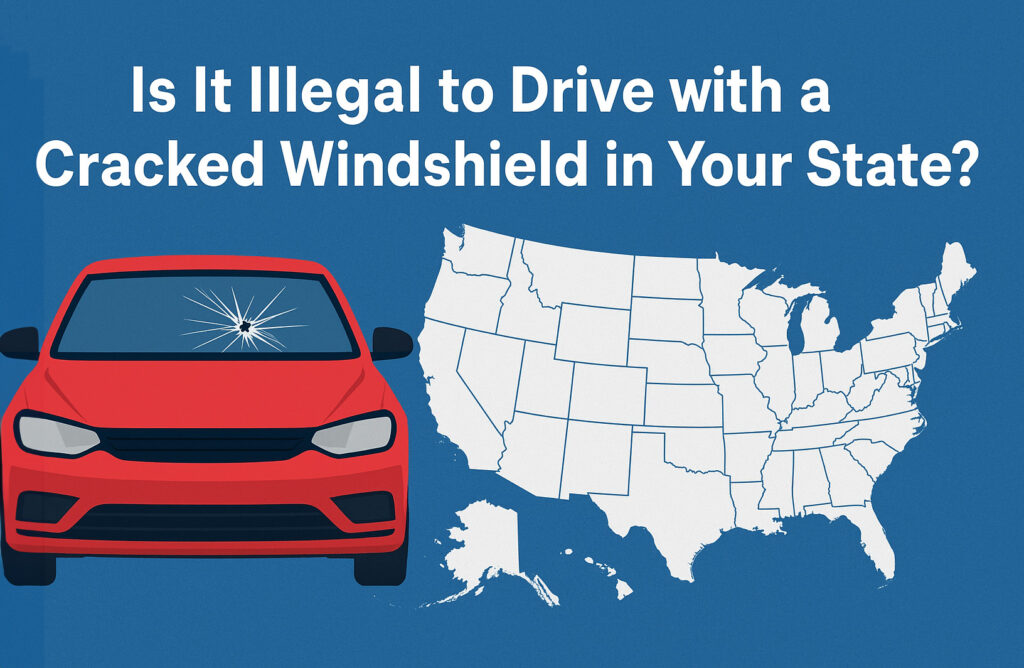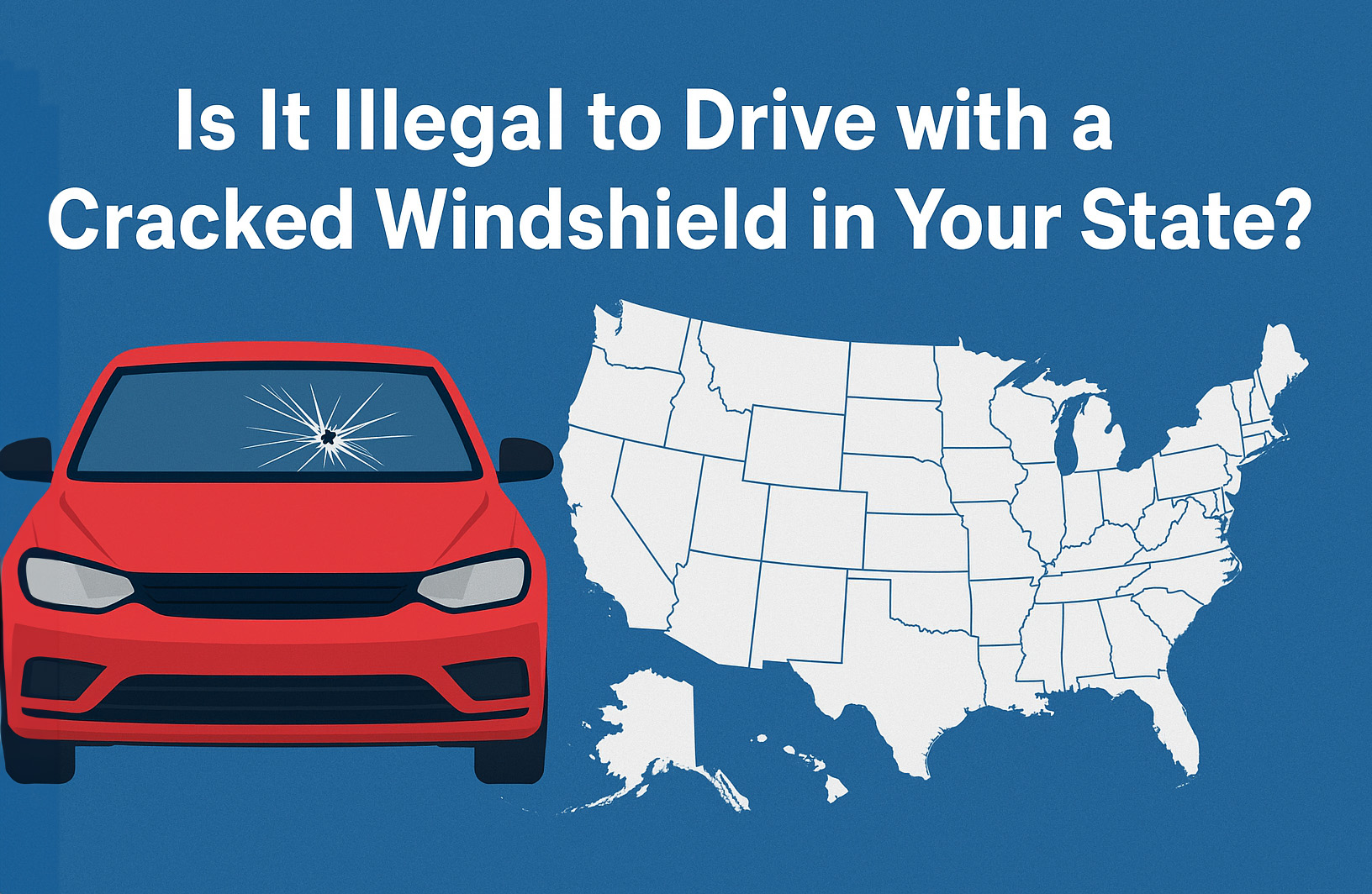A cracked windshield might seem like just a small inconvenience, but depending on where you live, it could put you on the wrong side of the law. Beyond the legal aspect, cracks and chips can compromise visibility, weaken the windshield’s structural integrity, and even affect how airbags deploy during an accident.
But is it illegal to drive with a cracked windshield in your state? The answer varies across the U.S., with each state having its own rules and levels of enforcement. Below is a detailed state-by-state breakdown of what you need to know—plus practical solutions to keep your vehicle road-safe and compliant.
Why Windshield Laws Exist
Windshield regulations aren’t just red tape. They exist to ensure:
- Driver visibility – even small cracks can distort vision.
- Passenger safety – the windshield is a structural component in rollovers.
- Airbag effectiveness – airbags rely on the windshield to deploy properly.
- Traffic enforcement – damaged glass may give law enforcement probable cause to pull you over.
If your windshield damage obstructs your line of sight, expect to be stopped almost anywhere in the country.
General Federal Guidance
While federal regulations (FMVSS 205) set standards for windshield materials and driver visibility zones, actual enforcement falls to states. This means each state sets its own rules on cracks, chips, and repairs.
State-by-State Windshield Crack Laws
Here’s a simplified breakdown of cracked windshield laws across the United States.
Alabama – Wyoming
- Alabama: No specific crack size limit, but obstruction of view is prohibited.
- Alaska: Cracks larger than ½ inch in driver’s view are not allowed.
- Arizona: No specific law, but anything obstructing the driver’s vision can result in a ticket.
- Arkansas: Windshield must be free from “non-transparent” materials or damage in the driver’s view.
- California: Cracks directly in the driver’s line of sight are illegal.
- Colorado: Requires unobstructed view; cracks impeding visibility are illegal.
- Connecticut: No explicit statute, but drivers can be cited if visibility is impaired.
- Delaware: Obstruction by cracks or chips in driver’s view prohibited.
- Florida: Vehicle must have an intact windshield with no obstructing cracks.
- Georgia: Damage that obstructs clear vision is prohibited.
- Hawaii: Cracks larger than ½ inch in driver’s view are illegal.
- Idaho: No specific measurements; officers can ticket if vision is obstructed.
- Illinois: Any cracks or chips larger than a quarter in driver’s view may lead to a citation.
- Indiana: Must maintain clear visibility; cracks in driver’s field can result in a violation.
- Iowa: Cracks that interfere with visibility are illegal.
- Kansas: No set size, but impairments in driver’s field of vision are not allowed.
- Kentucky: Cracks that obscure vision prohibited.
- Louisiana: Damage in driver’s field of vision is not permitted.
- Maine: Vehicle inspections fail if windshield has cracks in wiper-swept area.
- Maryland: Cracks larger than ½ inch in driver’s field prohibited.
- Massachusetts: Vehicle won’t pass inspection with damage in critical areas.
- Michigan: Damage impairing vision prohibited.
- Minnesota: Any cracks in driver’s direct line of sight illegal.
- Mississippi: Vision must not be impaired by cracks or chips.
- Missouri: Damage in driver’s field of vision prohibited.
- Montana: No specific size, but unsafe obstructions cited.
- Nebraska: Cracks larger than ¾ inch in driver’s field are illegal.
- Nevada: Obstructed view due to cracks or chips is prohibited.
- New Hampshire: Strict—no cracks or chips larger than 1 inch allowed in driver’s field.
- New Jersey: Vehicle will fail inspection with cracks in driver’s view.
- New Mexico: No explicit law, but obstruction of view not allowed.
- New York: Strict inspection requirements—damage in driver’s line of sight prohibited.
- North Carolina: Prohibits cracks larger than ¾ inch in critical viewing area.
- North Dakota: Must maintain safe vision; cracks in driver’s area are violations.
- Ohio: Cracks longer than 3 inches in driver’s field prohibited.
- Oklahoma: No specific size, but obstruction of vision not allowed.
- Oregon: Requires clear, unobstructed view; large cracks prohibited.
- Pennsylvania: Strict inspection standards—cracks in driver’s side not permitted.
- Rhode Island: Vehicle won’t pass inspection if windshield obstructed.
- South Carolina: Cracks larger than ½ inch in driver’s view prohibited.
- South Dakota: Obstructions in windshield not allowed.
- Tennessee: Requires unobstructed visibility; cracks in driver’s view are violations.
- Texas: Technically no set size, but officers may cite if cracks obstruct view.
- Utah: No cracks or chips larger than 1 inch in driver’s field.
- Vermont: Any damage impeding vision is illegal.
- Virginia: Cracks larger than ¼ inch wide or longer than 3 inches in driver’s field prohibited.
- Washington: Cracks obstructing wiper-swept area prohibited.
- West Virginia: Cracks larger than 1 inch in driver’s field prohibited.
- Wisconsin: Requires clear vision; cracks in driver’s view are illegal.
- Wyoming: Obstruction of driver’s vision not permitted.
What To Do If You Have a Cracked Windshield
If your windshield is cracked, here are safe solutions:
- Assess the Damage – Small chips (under a quarter in size) can sometimes be repaired.
- Get It Fixed Quickly – Cracks spread due to vibration, heat, and cold.
- Check Your Insurance – Many policies cover windshield repair or replacement with little or no deductible.
- Use Trusted Shops – Poor-quality replacements can lead to leaks, ADAS miscalibration, or reduced crash safety.
- Compare Local Options – Use our free windshield replacement quote tool to compare up to three trusted shops near you. This helps you save money and ensures safe, professional service.
Final Thoughts
Driving with a cracked windshield is not just a safety hazard—it could also put you at risk of a ticket depending on your state’s laws. While some states are stricter than others, the rule of thumb is simple: if it blocks your view, it’s illegal and unsafe.
Don’t wait until a small crack becomes a big problem.
Use our free quote tool today to compare local windshield repair and replacement shops, and keep your vehicle safe, legal, and road-ready.

To read more, visit blog.glass.net

